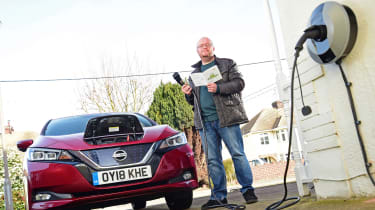How to charge an electric car: a complete guide
Charging an EV can seem daunting; we explain cable types, where to find a charger and the etiquette surrounding it all
Electric cars need to be plugged in to charge, in much the same way as a mobile phone or laptop. Unlike petrol or diesel cars, which need to be filled up, they run on electricity supplied by the National Grid.
Plug-in hybrid vehicles (PHEVs) are a mix of both – their batteries can be charged via a plug socket to run for short distances on electric power alone, but there’s also a petrol or diesel engine under the bonnet that needs to be refilled in the conventional way for longer distances.
Charging sockets on electric cars have evolved over time, but have recently started to become more uniform. Most plug-in cars now use Type 2 charger cables as standard, with one or two exceptions.
It’s possible to charge an electric car using a household three-pin plug like a laptop or mobile phone, but it isn't the most efficient method – prepare to be waiting around for hours on end – and isn’t recommended unless you have no other choice.
Home wallbox charging units are the preferred day-to-day charging solution and can cut charge times down to a few hours. For longer drives where faster charging is needed along the way, public rapid-charging stations can top up an electric car in a matter of minutes.
With different types of chargers, connectors and ways to pay for public charging stations to consider, charging an electric car can seem daunting. It's much easier than you might think, though, so read on to find out everything you need to know about how to charge an electric car and a more detailed look at each type of top-up – as well as a few etiquette tips if you’re new to charging away from home.
Electric car charger types explained
In the early years of electric cars, one of the biggest dilemmas surrounded the kind of charging sockets and cables they would use. While fuel pumps and octane levels have long been standardised across various countries, electric vehicle manufacturers initially developed different connectors that best suited their cars’ batteries. However, in Europe there has been a big push to simplify things. In 2014, the European Commission ruled that all new plug-in vehicles and all new charging stations should feature a Type 2 (occasionally called a Mennekes) connector.
Even though new plug-in vehicles now feature Type 2 sockets as standard, a single car may be compatible with multiple cables. That is to say a cable with a Type 2 connector at one end may have a different connector at the other, allowing it to plug into some power sources, but not others. Not all plug-in cars come with a Type 2 cable as standard: some manufacturers will force you to buy them separately as an optional extra.
Can I use a three-pin plug to charge my electric car?
Yes you can, but it’s not recommended. Most electric vehicles and plug-in vehicles are supplied with a home charging cable that can be plugged into a regular socket. Bear in mind that the maximum current a home socket can draw is around 2-3kW. This means fully charging an electric vehicle such as the best-selling Tesla Model Y RWD with its 57.5kWh battery will take over nine hours.
Not all sockets can supply as much as 3kW reliably: it's common for power to drop to 2kW (or lower), which will extend charging times even further. Another drawback is that sockets aren’t often near a driveway, so you will likely have to use an extension cord. Using an extension cable can be dangerous, as drawing maximum current for a long period of time could potentially be a fire risk.
Type 1 socket
This is a single-phase socket that allows a maximum charge speed of 7.4kW. They're predominantly found on older electric cars – such as the first-generation Kia Soul – in Europe. Some home and public charging units come with Type 1 connectors, although there are no public charging stations that only provide Type 1 cables. If you have a cable with a Type 1 plug at one end and a Type 2 plug at the other, you should be able to use the vast majority of public charging points.
Type 2 socket
The Type 2 socket is the most common kind on new electric cars and on most home wallbox chargers too. Like the Type 1 socket, it allows a maximum, single-phase charging speed of 7.4kW, however it's also compatible with three-phase supplies – usually found in public places such as industrial estates – providing up to 22kW. Houses can be upgraded to three-phase, but this requires work from a qualified electrician, and is usually very expensive.
Commando socket
This style isn’t very popular, as it was featured on cars such as the Ford Focus Electric and other lesser-selling electric vehicles. Some public charging stations feature this connector, but they are rare.
CCS socket
This is a rapid DC charging connector, developed by a consortium of German and American car makers including VW, Audi, Porsche, General Motors, Ford, Mercedes-Benz and BMW. CCS stands for Combined Charging System, and it’s the favourite among European manufacturers as well as some Asian makers such as Hyundai.
These are found only at public charging stations, which commonly work at speeds of 50kW or faster. Your car must have a CCS socket to be able to use the rapid chargers. Ultra-rapid charging stations – such as those on the growing IONITY network – can provide up to 350kW of power via a CCS connection.
In reality this is preparation for the future: no electric cars on sale in the UK can currently ingest electricity at that rate. The Porsche Taycan is capable of 268kW charging, while the Hyundai Ioniq 5 maxes out at around 230kW. While initially the preserve of high-end models, speeds of 150kW are now more commonplace.
CHAdeMO sockets
While CCS is a rapid DC charging technology developed by German and American manufacturers, CHAdeMO is its Japanese counterpart. Developed by Nissan, Toyota, Mitsubishi and a host of electrical appliance firms, CHAdeMO is Japan’s answer for rapid DC charging connectors. Again, cars have to feature a specific CHAdeMO socket to be able to use the connectors provided at public charging stations. The good news is that all rapid DC charging stations that supply CCS connectors also supply CHAdeMO connectors – capable of supplying power at around 50kW.

How to use a home wallbox electric-car charger
Most plug-in car owners will install a wallbox charger to make charging their vehicles more convenient. You can either buy a tethered unit where the charging cable is attached to the box, or you can get an untethered one with just a socket, leaving you to provide the cable. Read our guide to tethered and untethered home chargers for more information.
Charging is simple in either case: locate the socket on your vehicle (usually obscured by a cap, just like a fuel-filler cap) and plug in the cable. Lights in the wallbox will indicate whether charging has commenced, and most cars will have a read-out of their own on the dash or infotainment screen.
How to use a public electric-car charger
Public chargers are slightly different from home chargers. Previously, some required a subscription account or an RFID (radio frequency identification) card in order to access them, while others worked on a pay-as-you go basis. These days, all new chargers are obligated to offer pay-as-you-go access, although frequently those who do sign up for membership or subscription enjoy preferential pricing.
To find the nearest ones, Zap-Map has the most comprehensive map of public chargers in the UK – though we’ve found it often isn’t that quick to update with the latest locations. Regardless, you can specify the type of connectors and speeds you’re after in order to refine your search. Click on the individual station icons, and it will tell you what the payment rates are – usually expressed in terms of pounds per kilowatt-hours – and whether or not you need a subscription account.
The actual charging process is as easy as with a home charger. Drive to an available bay, either pay in advance or use a subscription card to unlock the charger, and then simply connect the cable to your car’s socket.

Charging etiquette
Politeness is as much of a pillar of British society as drinking tea and talking about the weather. With this in mind, we’ve come up with a list of till-now-unwritten charging etiquette rules that you should try to follow in order to prevent getting in a feud at the forecourt.
Be courteous
As much as this sounds obvious, be courteous to your fellow EV drivers. If you see someone struggling, offer to help. We’re all in the same boat and helping others means we’ll all be back on the road faster and easier.
Don’t unplug someone else’s car
As tempting as it may be to do so, don’t unplug someone else’s car. You don’t know what level of charge may be at and regardless, you wouldn’t want someone to do the same to you. Regardless, most EVs have a lock to prevent this being done anyway.
Electric cars should take priority over PHEVs
If you’re driving a plug-in hybrid, allow fully-electric cars to take priority when queuing to charge. While you have a petrol or diesel engine to fall back on, EVs don’t have that luxury and depend on charging to continue the journey. A recent survey by Vauxhall suggested that 55% of EV drivers would allow those who needed a quick top-up to go in front of them, compared with only 15% of petrol and diesel car drivers.
Monitor your car’s state of charge
Despite the growing number of public chargers, queues can still form at busier locations. Therefore, it’s important to keep an eye on your car’s level of charge in order to make sure it isn’t taking up valuable charging real estate – many cars have smartphone apps that allow you to do this from afar, while some rapid chargers have displays to allow you to monitor your battery percentage and charging speed.
Keeping an eye on your car’s level of charge has a practical purpose, too – manufacturers recommend only charging your car to 80% to preserve the life of the battery.
Take care of the charging equipment
This goes without saying but be careful with the charging equipment – being careless can result in damage which could prevent other drivers from using it. Make sure to stow the cable after you’ve finished charging and if you notice any damage, be sure to report this to the operator.
